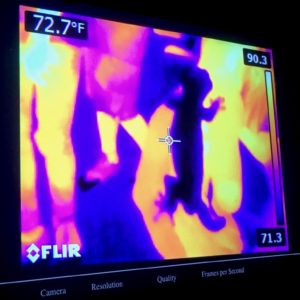When we set out to show you science in a whole new way, we often mean that literally. A popular demonstration we include in our summer camps showcases infrared light. Infrared (IR) means “beyond the red” and is typically not visible to human eyes. Its relatively long wavelength puts IR on the electromagnetic spectrum between visible and radio waves.
Here, our Dr. Billy Teets pointed an infrared camera at his pet lizard, Niels Bohr, who was being held by a camper, to demonstrate the relationship between heat and infrared radiation. The camera easily identifies the relatively cool temperatures of the cold-blooded lizard and floor with black and blue tones, differentiating them visually from the campers’ warm arms and legs, which are shown with much “warmer,” bright yellow tones.
The discovery of infrared radiation has an interesting history. William Herschel, who also discovered Uranus two decades earlier, put a prism in sunlight to create a spectrum. He took temperature measurements in the different color areas finding a large disparity: red gave an average reading of 67/68 degrees above the ambient temperature, green gave 31-34 additional degrees, and violet light typically only gave a 2-degree increase. When he placed the thermometer outside of the spectrum–“beyond the red”–Herschel found that temperatures continued to rise, before eventually dropping off. This experiment demonstrated that “invisible” light was hitting his thermometer and that radiant heat has the same optical properties as light.
Infrared technology has many scientific and daily uses: NASA’s SOFIA mission studies the infrared universe in the stratosphere from a Boeing 747, many consumer electronic remote controls operate with IR, as does some night vision equipment.
Imaging by Dr. Billy Teets, photo by Alex. Rockafellar
<- Previous May 15, 2020 Next ->
Tucked up among the wooded hilltops of northern Brentwood, Vanderbilt Dyer Observatory is considered by many to be a hidden treasure of the area. Visitors to our satellite campus not only learn about some of the cutting-edge discoveries and science in astronomy but they also get a dose of nature, history, and many other things while here. Over the years, we at Dyer Observatory have made the preservation of our facility and grounds a key mission. Preservation not only entails things such as maintaining our telescopes — it also includes keeping a record of days passed. Since 1953, we have amassed a number of interesting images, pieces of equipment, and ephemera. Every day tends to bring new surprises. In continuing our tradition of public education and outreach, Stellar Finds regularly provides an image and description of the diverse paraphernalia associated with Vanderbilt Dyer Observatory and the history of astronomy at Vanderbilt University.
